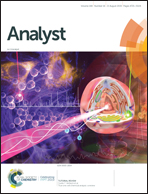Continuous separation of fungal spores in a microfluidic flow focusing device†
Abstract
The research of fungi is of great importance in a number of fields, such as environmental and healthcare studies. While there are a large number of optical and molecular methods available for characterization and identification of fungi and their spores, their isolation is still conducted using slow and labor-intensive methods. Here, we develop a microfluidic device for the continuous separation of fungal spores from other eukaryotic cells. The spores were separated through the microfluidic device by expanding pinched flow fractionation (PFF) containing the spores, achieving a spatial separation perpendicular to the flow direction according to the spore size. Further branch flow fractionation (BFF) and co-flow of a Newtonian and viscoelastic fluid were used to enhance the separation performance. Using this microfluidic device, we demonstrated the separation of two different types of fungal spores and further separation of fungal spores from eukaryotic cells with a separation efficiency of above 90%. Compared to the existing conventional methods, our microfluidic flow focusing device requires little manual handling and uses small amounts of samples without any pre-treatment steps of the samples.



 Please wait while we load your content...
Please wait while we load your content...